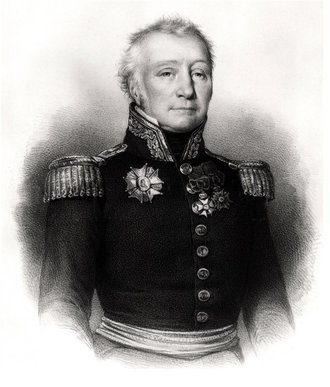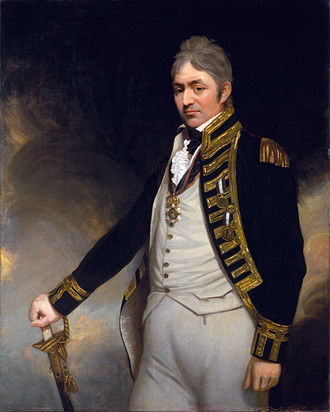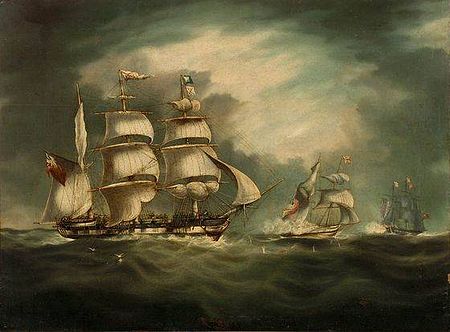|
NAVAL ENGAGEMENT WITH THE FRENCH IN THE INDIAN OCEAN IN 1805.
On Wednesday 7th August 1805 at 4.30pm the crew of the Cumberland saw three strange ships closing in on the fleet of East Indiamen, within three minutes their Escort ship HMS Blenheim signalled to prepare for battle. The ships were French, we were at War and this was the year of Trafalgar. Admiral Charles-Alexandre Léon Durand Linois was on board the Marengo, supported by the frigates Belle Poule and Adalante.

Admiral Charles-Alexandre Léon Durand Linois,
1761-1848 by Antoine Maurin, from Wikipedia.
The Cumberland was part of the annual fleet slowly making its way to India and beyond. They were in the Indian Ocean at Lat. 19.31S by Long. 76.41E. There had been a strong trade wind with very hazy squalls and almost constant rain but the weather was moderating.
Admiral Linois did not want to get involved with the Blenheim, and maneuvered in an attempted to pick off one of the East Indiamen and hopefully to scatter the rest. The Cumberland bore the brunt but Captain Farrer held firm and the fleet remained in formation. Initially the Blenheim could not engage with the enemy because she was under manned and slower. After a couple of attempts Admiral Linois considered the risk too great and stood off.

Rear-Admiral Sir Thomas Troubridge
by William Beechey, from Wikipedia.
The British fleet consisted of a Royal Navy flag ship, the Blenheim commanded by Admiral Troubridge and Captain Bissell escorting ten East Indiamen. The logs of the Ganges and the Cumberland have now been published on this website with their individual impressions of the engagement. Details of the British and French ships are to be found towards the end of this article.
Admiral Linois had captured a valuable East Indiaman named Brunswick on 11th July 1805 and was cruising in the Indian Ocean looking for more prey. The website on Linois (https://en.wikipedia.org/wiki/Linois%27s_expedition_to_the_Indian_Ocean) records the following:-
...when he discovered a convoy [at 19.31S 76.41] of eleven large ships sailing eastwards along the trade route from the Cape to Madras. Closing to investigate the convoy, which was shrouded in fog, Linois was cautious, unwilling to engage until he was certain that no Royal Navy ships lay among the East Indiamen. In fact there was a Royal Navy Ship of the Line 74-gun 2nd rate frigate called the Blenheim Commanded by Admiral Sir Thomas Troubridge and Captain Austin Bissell.
The website goes on to record
The Blenheim was a powerful ship capable of inflicting fatal damage on Marengo even if the French managed to defeat her, an uncertain outcome given the presence of the heavily armed merchant ships. Instead, Linois swung in behind the convoy, hoping to cut off a straggler. These maneuveres were too complex for the poorly manned Brunswick, and she was soon left behind. At 17:30, Marengo pulled within range of the rearmost East Indiaman and opened a long-range fire, joined by Belle Poule. The rear ship Cumberland, a veteran of the Battle of Pulo Aura [in 1804], was unintimidated and returned fire as the Blenheim held position so that the convoy passed ahead and the French ships rapidly came up with her. Opening a heavy fire with the main deck guns, Troubridge was able to drive the French ships off, even though his lower deck guns were out of service due to the heavy seas that threatened to flood through the lower gunports. Linois, concerned for the safety of his masts, pressed on all sail and by 18:00 had gone beyond range of Blenheim's guns and overtaking the convoy and remaining within sight until nightfall.
At midnight, the French ships crossed the bows of the convoy and by morning were 4 nautical miles to windward, to the south. Troubridge maintained his line throughout the night and at 07:00 on 7 August 1805 he prepared to receive the French again as Linois bore down on the convoy. Retaining their formation, the combined batteries of the Indiamen and Blenheim dissuaded Linois from pressing the attack and he veered off at 2 nautical miles distance, holding position for the rest of the day before turning southwards at 21:00 and disappearing. Linois's withdrawal was prudent: his mainmast had been struck during the brief cannonade and was at risk of collapse if the engagement continued. Losses among the crew were light, Marengo suffering eight men wounded and Belle Poule none. British casualties were slightly heavier, a passenger on Blenheim named Mr. Cook was killed by langrage shot and a sailor was killed on the Ganges by an eight pound shot. No British ships suffered anything more than superficial damage in the combat, and the convoy continued its journey uninterrupted, arriving at Madras on 23 August.
Langrage - shot formerly used in naval warfare for tearing sails and rigging and consisting of bolts, nails, and other pieces of iron fastened together or enclosed in a canister.
The individual who lost his life on the Ganges was Private Darby McHugh of His Majesty’s 67th Regiment.
On board the Cumberland the story was told thus:-
At half past 4pm saw three Strange Ships to the ESE close in with the fleet and in a few minutes the Commodore made the Signal for their being enemies to form the order of Battle and to prepare for action, immediately turned the hands to Quarters & cleared Ship for action. PM The Marengo bearing the flag of a Rear Admiral passed close and under our Lee Quarter and gave us his Broadside within about 100 yards off, also a second one with a volley of musquetry from his tops and Poop which we returned in the best possible manner. She then bore up a little and shot ahead towards the Exeter and the Blenheim. In a few minutes after this a large frigate passed close to us and gave us her Broadside and musquetry [musketry] and then passed on after the line of the Battle Ship we giving them our Broadside and musquetry as they passed as we could. All this time the weather was very dirty with much rain and blowing strong & at dark the Admiral made the Signal to close and carefully to observe his motion during the night.
At Daylight the enemy were in sight on our Starboard beam about 4 miles to windward & continued in that position until noon, sometimes bearing up and at other times keeping his wind, at which time they hauled close to the wind, we continuing our course in close order of Sailing and the Admiral in the rear of the fleet. All hands at Quarters during the whole time. Our damage consists of the Fore yard being shot through. The head of the main mast shot through above the rigging, and both the main Trestle Trees, two main shrouds, one futtock shroud one main Trees & Main Topsail Tye shot away with a great quantity of running rigging and our sails very much cut to pieces – fortunate no person either killed or wounded.
The following day we repaired the Main Topsail and from noon until sunset the Enemy kept close to the wind at which time they were more than Hull down to the windward of us. Kept all hands at Quarters all night and at Daylight the enemy were not to be seen from the mast head. At 9am went on board the Admiral as per Signal.
On board the Ganges the story was told thus:-
On Wednesday 7th August 1805, At ½ past 4 Repeated Signal Ships to Windward bear down & join the Admiral, ditto to prepare for Battle ditto the Strange Ships are suspicious ditto form in Close order of Battle ditto steer NNE. At ½ past 4 ditto make Sail ahead of the Fleet ditto with the Pendants of the Dorsetshire, Hope, Exeter, Castle Eden, Cumberland & Devonshire. At 6am Repeated Signal to Prepare for Battle. At ¼ past 6 ditto Mornington & Ann to pass within Hail. At ½ past 6 ditto Ships to Windward to bear down. Ditto to make Sail ahead of the Fleet. ¾ past 6 ditto with the Pendants of the Dorsetshire & Castle Eden & at 7 the Hope, Cumberland and Devonshire, ditto at 8 for the Hope to make more Sail. At 8 Repeated Signal for all Ships to pass within Hail.
At 4am Three Strange Ships bearing NE Standing towards us. Cleared Ship for action. At ½ past 4 the Strangers having passed us to Windward we bore up Close with HMS Blenheim and at 40 minutes past 4 Hove to in line of Battle about half a cables length ahead of her. At ¾ past 4 two of the Strangers only a line of Battle Ship & a Frigate. Passed through our line ahead of the Hope and Castle Eden and close to the Stern of the Cumberland then hauled up fired a Shot & hoisted French Colours, Commencing a brisk fire at the Cumberland & Blenheim which was instantly returned. The Enemy Standing on brought the Guns of the Exeter, Ganges, & Dorsetshire to bear almost immediately and shortly afterwards the Devonshire & Preston. The firing continued at intervals till ¼ past 5 when the Enemy from having Edged away got out of the Reach of our Shot. At ½ past 5 The Enemy making Sail Standing on with the Fleet. At ½ past 7 Spoke the Blenheim and received orders to keep close to her. At 8 The Enemy NNW about 5 Miles running ahead Our Fleet under easy Sail. Kept all hands at quarters. The Enemy having kept close to the Wind during the night were at daylight 6 Miles to Windward. At 6am formed the order of Battle the Blenheim bringing up the rear. At 7 and ½ past 8 The Enemy bore down & at 9 hauled up & kept under easy Sail at about 4 miles distance. Spoke the Blenheim & received orders from the Admiral to take Station the next ahead of him. AM Observed the Frigate Shifting her Fore & Mizzen Sails. At 10 the Enemy bearing East dropping astern. At Noon ESE under easy Sail keeping close to the Wind.
At Sunset the Enemy Hull down to Windward and at Midnight just in sight apparently on the other Tack. At daylight not in sight from the Mast Head. We received two Shots in our Counter and one under the Main Chains experienced no damage to the Sails. One Fore Shroud Stranded & little other damage to the Rigging. Darby McHugh Private of His Majesty’s 67th Regiment lost his life by a 12 pound Shot which afterwards lodged in the Hogstye [pigsty]. We suppose the French line a Battle Ship to be the strangers and the Vessel that hauled her Wind & made off to be a Prize."
The British fleet consisted of:-
- Blenheim was the Escort and Royal Navy's flag ship, Commanded by Admiral Troubridge and Captain Bissell. She was lost in a storm off the island of Rodrique in the Indian Ocean in February 1807;
- Devonshire Commanded by Captain James Murray. She was wrecked on the Saugor Sands in July 1814;
- Hope Commended by Captain James Pendergrass. Her last recorded voyage was in 1816;
- Preston Commanded by Captain Henry Sturrock. Her last recorded voyage was in 1812;
- Cumberland Commanded by Captain William Ward Farrer.
- Coutts Connanded Captain James Hay. She was sold for breaking in 1815;
- Ganges Commanded by Captain Thomas Talbot Harington. She struggled to complete her voyage but eventually sank off the Cape of Good Hope in May 1807;
- Exeter Commanded by Captain Henry Meriton. She was sold for breaking in 1811;
- Dorchester Commanded by Captain Robert Hunter Brown. Her last recorded voyage was in 1822.
- Mornington had sailed under the HEICS flag but was now on private business.
- Ann on private business
The French fleet consisted of:-
- Marengo, the flag ship, was a Téméraire class Man of War, launched in 1795, equipped with 80 guns and an a compliment of 744 men, it was Commanded by Admiral Linois. Captured by the British on 13th March 1806. In 1809 she was converted into a prison ship and on 31st Dec 1814. While at Portsmouth she was ordered to be broken up in 1816.
- Belle Poule, a copper bottomed fast frigate built at Bourdeau in 1768. A 40 eighteen-pounder frigate with a compliment of 320 men. She was captured, along with the Marengo, by the British on 13th March 1806. In 1814 she was a troop ship and by 1815 a prison ship. She was disposed of in 1818.

Belle Poule, Gypsy and HMS Hermes
by Thomas Buttersworth, from Wikipedia.
- Atalante, a 44-gun Virginie-class frigate, built in 1802 and Commanded by Captain Camille-Charles-Alexis Gaudin-Beauchêne.
Biography
- Farrington, Anthony: "Catalogue of The East India Ship's Journals and Logs. 1600 - 1834". British Library 1999.
- Farrington, Anthony: "A Biographical Index of East India Company Maritime Officers 1600 - 1834". British Library. 1999.
- The website https://en.wikipedia.org/wiki/Linois%27s_expedition_to_the_Indian_Ocean.
- The website https://en.wikipedia.org/wiki/Sir_Thomas_Troubridge,_1st_Baronet>.
- https://en.wikipedia.org/wiki/HMS_Belle_Poule_(1806).
- https://en.wikipedia.org/wiki/HMS_Blenheim_(1761).
- http://www.heicshipslogs.co.uk/.
|